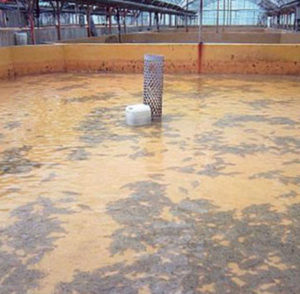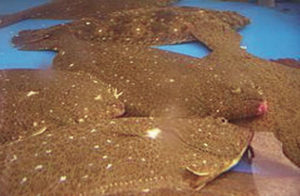The Republic of Korea is the leading global flatfish producer

Dietary protein is the most important nutrient affecting the growth of fish and the primary component affecting feed costs, as well. The protein requirements of fish vary greatly with respect to changes in biotic factors such as species and age, and abiotic factors that include rearing environment, water temperature, water quality and feeding rate. Protein supplementation in fish feed at suboptimal or excessive levels is both economically and environmentally unsound.
In general, protein requirements usually decrease as fish age from larval through adult stages and vary according to different carnivorous, omnivorous and herbivorous feeding habits. Thus, it is imperative to have a clear understanding of accurate protein requirements for each growing size of various economically important fish species.
Furthermore, the levels of protein and energy in fish diet should also be kept in balance. Theoretically, a dietary deficiency or excess of digestible energy can reduce growth rates in fish. Energy intake is a basic nutritional requirement, because maintenance of life processes takes priority over growth and other functions. Thus, energy concentrations with optimum protein levels are important considerations in diet formulations for fish.
Olive flounder nutrition
The Republic of Korea is the leading global flatfish producer, and olive flounders, Paralichthys olivaceus, rank first in Korean marine finfish aquaculture production. In 2012, annual olive flounder production was reported as 40,800 metric tons, contributing over 56 percent of total marine finfish aquaculture.
While culture operations for this species have expanded rapidly, feeding is still dependent on moist pellets and trash fish. Only 20 to 30 percent of farmers use extruded pellet diets. The authors conducted a study to determine the optimum dietary protein levels and protein:energy ratios for different age groups of olive flounders. This information could help promote the formulation of extruded pellet diets for this species.
Flounder larvae

Marine fish larvae are usually fed live feed, such as Brachionus plicatalis rotifers and nauplii of Artemia species brine shrimp until they are about 40 days or older, when they are weaned onto microparticulate diets. These diets are more convenient to use, less variable in nutrient composition, more likely to be nutritionally complete and often more cost-effective than live feed.
In the authors’ first experiments, fish averaging 0.3 ± 0.7 mg mean weight were fed one of six experimental diets: three laboratory-developed diets containing different levels of dietary protein and three commercial diets. The feed particle size for each diet was adjusted over the experimental period of 83 days. Fish fed the experimental diets were also concurrently fed live feeds until 45 days after hatching, as this is the normal procedure in commercial hatcheries.
Growth performance and survival data indicated that the optimum dietary protein level for maximum growth and survival of olive flounder larvae could be 60 percent crude protein. The laboratory-developed diets showed potential efficiency for rearing olive flounder larvae.
Flounder fry
As mentioned before, protein requirements usually decrease with increases in fish size, so comparatively lower protein requirements have been reported for various species of fish fry over larvae. In a further eight weeks of experiments, fish with weights averaging 4.10 ± 0.02 g were each fed one of five experimental diets containing 35, 45, 50, 55 or 65 percent crude protein.
Based on multiple analyses of weight gain, it was concluded that the optimum dietary protein level for olive flounder fry could be greater than 51.2 but less than 57.7 percent protein in fish from 4.1 to 18.2 g.
Flounder juveniles
In further work, juvenile fish averaging 13.30 ± 0.06 g were fed one of six experimental diets containing 30, 36, 42, 48, 54 or 60 percent crude protein. The percentage of weight gain linearly increased up to the group of fish fed 48 percent protein, then gradually declined.
Analysis of weight gain data suggested that the optimum dietary protein level for maximum growth of juvenile olive flounders could be greater than 44.0 but less than 50.2 percent crude protein.
Protein levels, P:E ratios
Eight experimental diets were formulated with two energy levels and four protein levels. At 12.5 kJ/g, diet crude protein levels were 25, 30, 35 and 45 percent, while at 16.7 kJ/g diet, protein levels were 35, 45, 50 and 60 percent. The energy levels of diets were calculated based on 16.7, 37.6 and 16.7 kJ/g diets for protein, lipid and carbohydrate, respectively. Triplicate groups of fish averaging 8.10 ± 0.08 g were fed one of the experimental diets for eight weeks.
At the end of the experiment, diets containing 45 percent crude protein and 16.7 kJ/g diet appeared to be utilized more efficiently in terms of feed efficiency, specific growth rate and protein retention than diets containing the other protein and energy levels. Based upon overall performance, it could be concluded that the optimum protein:energy ratios could be 27.5 mg protein/kJ with diet containing 45 percent crude protein and 16.7 kJ/g diet energy in juvenile olive flounders.
(Editor’s Note: This article was originally published in the July/August 2013 print edition of the Global Aquaculture Advocate.)
Authors
-
Dr. Sungchul Charles Bai
Professor, Director
Feeds and Foods Nutrition Research Center
Pukyong National University
Busan 608-737, Republic of Korea -
Kumar Katya
Gunhyun Park
Department of Marine Biomaterials and Aquaculture
Feeds and Foods Nutrition Research Center
Tagged With
Related Posts

Aquafeeds
Natural feed additives enhance rainbow trout performance
Various additives, many of plant origin, have been explored to replace the use of antibiotics in aquafeed. The authors compared the performance of rainbow trout fed diets containing oxytetracycline or mineral additives yellow loess and Song-Gang stone powder.

Intelligence
Bahamas venture focuses on grouper, other high-value marine fish
A new venture under development in the Bahamas will capitalize on Tropic Seafood’s established logistics and infrastructure to diversify its operations from processing and selling wild fisheries products to include the culture of grouper and other marine fish.

Health & Welfare
Aiding gut health with a natural growth promotor
A study with Nile tilapia conducted in commercial production cages in Brazil showed the potential – in the absence of major disease threats – of a commercial, natural growth promotor that modulates the microbiota (inhibiting growth of pathogenic bacteria and promoting growth of beneficial bacteria) and inhibits quorum sensing.

Aquafeeds
A look at protease enzymes in crustacean nutrition
Food digestion involves digestive enzymes to break down polymeric macromolecules and facilitate nutrient absorption. Enzyme supplementation in aquafeeds is a major alternative to improve feed quality and nutrient digestibility, gut health, compensate digestive enzymes when needed, and may also improve immune responses.


